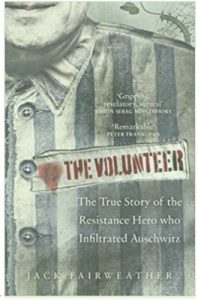Book Review: The Volunteer

True Story of the Resistance Hero who Infiltrated Auschwitz, by Jack Fairweather, WH Allen, 2019.
Review by Nick Fox OBE, Deputy Col Comdt
At the outbreak of World War II, Witold Pilecki was a gentleman farmer and junior officer in
a reserve cavalry unit of the Polish Army. At the end of September 1939 Poland was a defeated
nation, occupied by Nazi Germany and the Soviet Union; Pilecki joined the Polish
underground.
In November, he helped to form the Tajna Armia Polska (Secret Polish Army) acting as its
chief recruiter. The SS started mass arrests of Poles and by January 1940, 150,000 had been
deported; the leader of one resistance group began documenting these Nazi crimes and
smuggling details to the Polish government in exile, in the hope these would stiffen the resolve
of British and French allies in Poland’s favour. Initial reports mentioned a camp in Poland
which mirrored the ‘protective custody’ regime of those in Germany; this was a former Polish
Army cavalry barracks at Oswiecim, the name of which, in German, would later become
synonymous with mass murder: Auschwitz. It was thought that as long as this camp remained
unknown, the Germans were free to do anything they liked there and so a search was started
for someone to infiltrate it. Pilecki’s name was put forward; the task was to infiltrate the camp,
collect intelligence about it, create a resistance cell and stage a breakout.
Given the risks, Pilecki could not be ordered to undertake the mission, he would have to
volunteer. Despite the need to abandon his family and run the risks of being unmasked as a
former Polish officer and resistance leader, he stepped forward. Placing himself in a location
which the Secret Army knew was to be raided, he allowed himself to be arrested and on 21
September 1940 arrived in Auschwitz as a prisoner. The book documents, in incredible detail,
his arrival and brutal initiation, underlined by the warning from a senior German official: ‘Let
none of you imagine that he will ever leave this place alive.’ Despite the significant risks of
betrayal, which could be motivated by just the promise of an extra crust of bread, he began
recruiting among the ranks of prisoners, singling out former soldiers, friends and relatives. He
slowly built an effective network inside the camp and eventually established links to the local
community. He now had the means to collect intelligence and disseminate it.
The Volunteer goes on to describe how Pilecki, over the next two and a half years, recorded
the development of Auschwitz from a punishment and work camp for ‘enemies of the state’,
into a pivotal part of the Nazi extermination programme, forged at the Wansee Conference of
January 1942. He documented in detail the suffering and fate of thousands of Russian POWs;
experiments in eliminating sick prisoners; the arrival of French Jews; the trials of gas for mass
murder and, in November 1941, the start of the camp’s ‘annexe’ at nearby Birkenau. The author
cleverly tracks Pilecki’s activities in the camp alongside the war’s progress, with the reader
becoming increasingly conscious that, despite Pilecki’s unwavering focus on his mission, his
various reports were failing to have the impact that was hoped for.
Pilecki’s courage and determination shine through the book like a beacon. His mission cost
many members of his network their lives; in the face of almost unbelievable hardship and
suffering, the daily risk of exposure and nearly dying himself from typhus, Pilecki continued
to build his network even advocating, in one report, Allied bombing of the camp to prevent
further cruelty.
The book is remarkably well researched, drawing on Pilecki’s painstakingly detailed reports
which survived the war. Attempts by Polish historians in the 1960s to tell Pilecki’s story, were
confounded by his use of code and it was not until the 1990s that his unpublished memoir and
a further report, which revealed the key, came to light. The author spent five years pulling these
together, supported by the testimony of family and a surprising number of witnesses who knew
Pilecki, with collateral drawn from an impressive number of international archives, not least
the Auschwitz-Birkenau State Museum. The result is a book which reads like a thriller, with
pace and suspense to the extent that readers might often find themselves having to pause and
remember this all actually happened, exactly as described. The book holds little back and the
descriptions of human suffering, and the Nazi officials’ indifference to it, are not for the fainthearted.
Pilecki’s personal reaction to it is described in his own hand: his concerns for his coconspirators; his helplessness at their fate; and his shame for becoming ‘emotionally distant’
from the suffering of others. It was this factor, plus his frustration at the apparent lack of Allied
response, that caused him to plan his own escape in April 1943, during which he was shot but
survived. The last third of the book charts his survival in the Polish underground (during which
he diligently rewrote all his intelligence reports), his part in the Warsaw Uprising, survival in
a Bavarian POW camp until liberation in 1945 and his return to Poland – now under Soviet
domination – to create another intelligence network. It was this that led to his arrest in May
1947 and his torture and execution in 1948 at the hands of his own (now communist)
countrymen, following a show trial which portrayed him as a traitor. Ironically, his wartime
heroism was erased from Polish history and only surfaced after the communist collapse of
1989.
For the reader who is concerned with the evidence, the detail of which, at many points, is almost
too difficult to believe, the author has meticulously included details of all his sources and
references. The book contains useful maps and diagrams which help contextualise Pilecki’s
story and is well illustrated, with post-war sketches and drawings provided by former inmates
which bring to life the verbal descriptions of the camp’s horrific routines. These are augmented
by contemporary camp photographs of prisoners. The shaven heads and striped uniforms,
presented triptych-like, portray the Nazi attempts to strip prisoners of their dignity;
simultaneously, however, they allow the face to be put to the name, whether they are Pilecki’s
comrades or the dreaded Kapos (camp police drawn from the ranks of the prisoners).
The book appeals on several levels. It describes, with almost forensic detail, daily life – and
death – in the camp; the work of the Polish underground, both inside and outside of Poland;
the attempts by the Poles in exile to influence the Allies’ response; and the wider strategic
events that shaped that response, such as it was.
Intelligencers reading the book will appreciate the human intelligence process and the huge
risks involved; the difficulties of collecting and recording data; the search for and trust placed
in couriers who could disseminate the product; the frustration of the absence of a response from
‘higher command’; and the apparent lack of exploitation of accurate intelligence. That aside,
the book is also an inspiring account of a soldier and leader, who, in the direst of circumstances,
focussed steadfastly on his intelligence mission, whatever the personal cost. The traditional
epithets of ‘courage’, ‘determination’ and ‘endurance’ hardly seem adequate, especially when
one is reminded that Witold Pilecki was ‘a volunteer’.
If any satisfaction, on a local level, is to be derived from these tragic events it is perhaps the
fact that Auschwitz’s commandant, Rudolf Höss, was located, arrested and questioned by
members of the Intelligence Corps, as a result of which he confessed to his awful crimes and
was tried in Poland for murder.
Jack Fairweather’s book was the deserved winner of the Costa Book of the Year in 2019. It is
essential reading for anyone who wishes to understand how Auschwitz (and Birkenau) evolved
and operated on a daily basis. It should also be mandatory reading for all students to better
understand how dictatorships and extremism – of any hue – inevitably restrict human freedom
and create suffering to gain and retain control. The Volunteer is highly recommended as both
a record and a warning.
